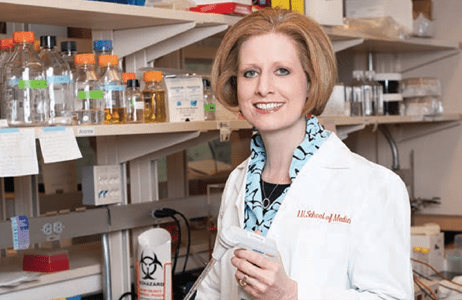In life, timing is everything. The same may be true when it comes to treating Type 1 diabetes.
Diabetes occurs when beta cells, which produce insulin, stop working correctly. We now know that beta cells become stressed or injured at least 10 years before a patient first experiences symptoms.
“By the time the patient comes to clinical recognition, 80 to 90 percent of beta cells have been destroyed,” said Carmella Evans-Molina, MD, PhD, an associate professor of medicine and leader in diabetes research at Indiana University School of Medicine. “Very little can be done at that point.”
Evans-Molina’s goal is to identify the first hint of beta cell stress or death and to begin treatment immediately. But that is easier said than done. Beta cells are buried deep inside the pancreas, making it hard to know when something is going wrong. Physicians can’t simply examine the cells with standard imaging techniques like x-rays or MRIs.
So Evans-Molina–in collaboration with Raghu Mirmira, MD, PhD; Emily Sims, MD, PhD; Linda DiMeglio, MD, MPH; and Janice Blum, PhD–is on the hunt for biomarkers, or warning signs, for Type 1 diabetes. By comparing samples of blood and urine from children with diabetes to those without the disease, their team can look for important differences—like flecks of proteins or molecules floating in the blood that wouldn’t usually be there. These clues may signal beta cell dysfunction and may help detect diabetes earlier.
To support this research, Evans-Molina is creating a bank of biological samples. Every time a child with Type 1 diabetes is admitted to Riley Hospital for Children at IU Health, the family is asked to allow researchers to collect blood and urine. These samples are then used by the IU team and researchers around the world to search for biomarkers and conduct other experiments.
“We want to know what is floating around in you when beta cells are happy versus when they are stressed,” Evans-Molina said. “Then we can start to predict who is at risk for diabetes and potentially prevent further damage.”
Carmella Evans-Molina, MD, PhD, is the J.O. Ritchey Scholar in Medicine, director of the pediatric diabetes research program at the Herman B Wells Center for Pediatric Research, and Associate Director of Development and Community Engagement at the Center for Diabetes and Metabolic Diseases.
This story was originally published in the Summer 2018 edition of IU Medicine Magazine.
